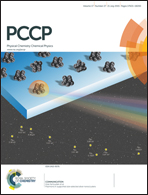Magnetic liposomes based on nickel ferrite nanoparticles for biomedical applications†
Abstract
Nickel ferrite nanoparticles with superparamagnetic behavior at room temperature were synthesized using a coprecipitation method. These magnetic nanoparticles were either covered with a lipid bilayer, forming dry magnetic liposomes (DMLs), or entrapped in liposomes, originating aqueous magnetoliposomes (AMLs). A new and promising method for the synthesis of DMLs is described. The presence of the lipid bilayer in DMLs was confirmed by FRET (Förster Resonance Energy Transfer) measurements between the fluorescent-labeled lipids NBD-C12-HPC (NBD acting as a donor) included in the second lipid layer and rhodamine B-DOPE (acceptor) in the first lipid layer. An average donor–acceptor distance of 3 nm was estimated. Assays of the non-specific interactions of magnetoliposomes with biological membranes (modeled using giant unilamellar vesicles, GUVs) were performed. Membrane fusion between both aqueous and dry magnetoliposomes and GUVs was confirmed by FRET, which is an important result regarding applications of these systems both as hyperthermia agents and antitumor drug nanocarriers.



 Please wait while we load your content...
Please wait while we load your content...